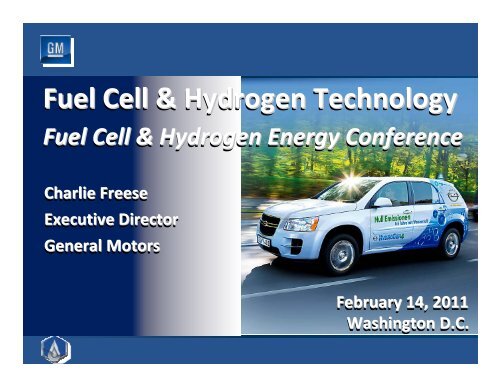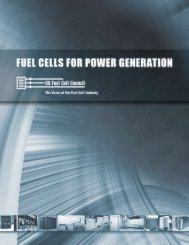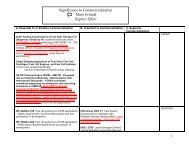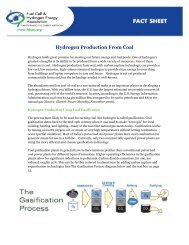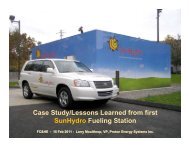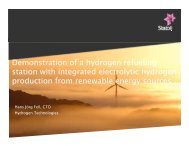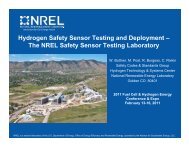Fuel Cell & Hydrogen Technology Fuel Cell & Hydrogen Technology
Fuel Cell & Hydrogen Technology Fuel Cell & Hydrogen Technology
Fuel Cell & Hydrogen Technology Fuel Cell & Hydrogen Technology
You also want an ePaper? Increase the reach of your titles
YUMPU automatically turns print PDFs into web optimized ePapers that Google loves.
<strong>Fuel</strong> <strong>Cell</strong> & <strong>Hydrogen</strong> <strong>Technology</strong><br />
<strong>Fuel</strong> <strong>Cell</strong> & <strong>Hydrogen</strong> Energy Conference<br />
Charlie Freese<br />
Executive Director<br />
General Motors<br />
February 14, 2011<br />
Washington D.C.
What comes next?<br />
Sometimes we are just too close<br />
Perspective
Overview<br />
Perspective<br />
Historical Look at:<br />
<strong>Technology</strong> Investment<br />
Infrastructure Investment<br />
What does that mean for us?<br />
What’s Next?
Five Stories from History<br />
Two on <strong>Technology</strong><br />
• Apollo Space Program<br />
• Nuclear Energy Age<br />
Three on Infrastructure
Apollo Space Program<br />
What makes a “moon shot”<br />
Costs & benefits of<br />
technology investments
Technological Innovation<br />
Human travel to the moon has been a long standing dream<br />
Jules Verne novel –“From Earth to the Moon,” 1865
Race to the Moon Begins<br />
Soviet Union’s Space Program Firsts<br />
First Man Made Satellite orbits Earth –October 4, 1957<br />
Yuri Gagarin ‐ First Human in Space –April 12, 1961<br />
Alexei Leonov ‐ First Human Extra‐Vehicular Excursion –March 18,
Technological Innovation – Competition<br />
Clear vision established –May 25, 1961<br />
"I believe that this nation should commit itself to achieving the goal,<br />
before this decade is out, of landing a man on the moon and returning<br />
him safely to the earth."
Technological Innovation<br />
Putting Technological Reach & Risk/Reward into Perspective<br />
What makes a “Moon Shot”<br />
Rapid Technological Advancement<br />
Disruptive <strong>Technology</strong> –Game Changing<br />
Vision for Success –But No Clear Path (means) to the End State<br />
Are fuel cells & hydrogen infrastructure a “Moon Shot?”<br />
Are the costs justified & the rewards worthwhile?
GM Electrovan (1966)<br />
World’s first hydrogen fuel cell vehicle<br />
At this point, commercial hydrogen fuel cells were still a “Moon Shot”
Technological Innovation<br />
When is a trip to the moon, no longer a “Moon Shot?”<br />
7 lunar landings<br />
Saturn V: 363 ft tall; 6.5 Million pounds (fueled by liquid H 2 & O 2 )<br />
Required a 52 story vehicle assembly building<br />
One quarter the height of the Empire State Building<br />
42 ft. longer than the Spruce Goose & 131 ft. longer than Boeing 747<br />
When we have been there and we know we can do it
Vehicle Deployment<br />
Real World Experience<br />
119 Project Driveway Vehicles in 6 Countries<br />
Approaching 2 MILLION accumulated miles<br />
Performed through 3 full winters<br />
20,000 refueling events, 47,000 kg H 2<br />
<strong>Hydrogen</strong> fuel cell vehicles are no longer “Moon Shots”<br />
H 2 <strong>Fuel</strong> <strong>Cell</strong> technology is commercial ready<br />
• Performance proven in field, durability proven in labs<br />
• Cost pathway identified (Comparable to other adv. tech.)
Global H 2 Supply<br />
How much is already there?<br />
Today: > 50,000,000 tons per annum<br />
Others<br />
1%<br />
Chemicals<br />
3%<br />
World car park<br />
Ammonia<br />
50%<br />
Oil<br />
Refining<br />
45%<br />
35%<br />
North America: Oil refinery H 2 alone, could fuel 21 million fuel cell vehicles<br />
A 2% increase in U.S. natural gas would support 10 million fuel cell vehicles<br />
Today’s Global H 2 production could fuel > 300 million fuel cell vehicles
<strong>Hydrogen</strong> Infrastructure<br />
Key Building Blocks Exist
Unintended Benefits –How do you quantify it?<br />
Spin‐Offs from U.S. Space Program<br />
Velcro Infrared Ear Thermometers Enriched Baby Food<br />
Freeze‐dried Food Artificial Limb <strong>Technology</strong> Water Purification<br />
Dustbusters Aircraft Anti‐Icing Systems Tang<br />
Cochlear Implants<br />
Teflon<br />
Solar Energy<br />
Highway Safety – Pavement Grooves<br />
Ventricular Assist Device<br />
<strong>Fuel</strong> <strong>Cell</strong> <strong>Technology</strong><br />
Improved Radial Tires<br />
$25.4B - 1974<br />
$125B<br />
(today)<br />
The benefits you seek may turn out to be the tip of the iceberg<br />
Difficult to quantify, but undisputed benefits to society & industry
Relationship between H 2 & Renewables<br />
Case Study –German Wind Energy (2008)<br />
• Renewable energy sources fluctuate<br />
dramatically<br />
• Although solar is more predictable, its<br />
$/kWh is 5X more than wind<br />
• Placing significant wind energy on line<br />
necessitates an energy buffering strategy<br />
‐ otherwise electricity generation costs<br />
can increase<br />
1) DEWI‐Report, 30.6.2008<br />
2) Bundesverband Windenergie e.V., 20.11.2008
<strong>Hydrogen</strong><br />
The Energy Buffer in the Renewable Energy System<br />
8000<br />
Source: KBB underground<br />
(MW)<br />
6000<br />
4000<br />
This much could be fed into an<br />
underground hydrogen reservoir<br />
(2 Mio m 3 salt cavern):<br />
600,000 MWh<br />
(equals 3.6 Mio tank fills)<br />
200<br />
0<br />
0<br />
Oct 1 Oct 3 Oct 5 Oct 7 Oct 9 Oct 11 Oct 13<br />
Only hydrogen offers energy storage capacity for several days
<strong>Fuel</strong> <strong>Cell</strong>s & <strong>Hydrogen</strong> Energy Jobs<br />
Most scenarios indicate substantial job creation opportunity<br />
Jobs Created or Retained in H 2<br />
Infrastructure<br />
Jobs Created or Retained in Green Energy<br />
Reference:Jeffrey Greenblatt,Clean Energy 2030<br />
The two largest hydrogen companies are US based. Commensurate<br />
with the above projections, H 2 capacity increase to meet 2020<br />
demand could encourage 200,000 new jobs by 2020 based on DOE<br />
rollout scenarios.<br />
<strong>Fuel</strong> cell jobs expected to be at least as great as those created in the<br />
solar & wind sectors<br />
2010 Industry Review conservatively estimates fuel cell manufacturing will<br />
experience its largest job growth over next 10 years, with almost 700,000<br />
cumulative manufacturing jobs created or retained, globally<br />
Could create more than 1 million new jobs in total, (including fuel cell installation,<br />
servicing, & maintenance).<br />
Expectation is that 25% of those jobs will reside in U.S.
The Dawn of the Nuclear Energy Age<br />
Cost of making a wrong<br />
decision<br />
Once you cross the line, can<br />
you go back?
Nuclear Energy Age Begins –“Uranverein”<br />
Reactor in Haigerloch –Germany April 1939 ‐ 1945<br />
1934 Fermi created radioactive element bombarding Uranium with neutrons, n<br />
Rome<br />
1938 Nuclear Fission Discovered - Otto Hahn & Firtz Strassmann , Berlin<br />
German nuclear program begins April 1939, during World War II<br />
In 1942 it was concluded the technology would not influence the war<br />
Control transferred from the Heereswaffenamt (Army Ordinance Office) to<br />
the Reichsforschungsrat (Reich Research Council)
Nuclear Energy Age Begins –Chicago Pile‐1<br />
University of Chicago –December 2, 1942<br />
$2.4B<br />
$24B (today)<br />
Danger in disregarding critical technologies too quickly<br />
Secret Manhattan Project with $6,000 initial investment for CP‐1<br />
CP‐1 initially ran for 28 minutes –The World was unaware<br />
Project ran through 1947
Technological Arms Race<br />
July 1945 (Trinity)<br />
Letting the genie out of the bottle<br />
Eventually, a single technology developer can no longer set the pace
Ongoing Investment<br />
First Vitrification Plant being built in CA – 2001 to 2019<br />
$12B<br />
(today)<br />
Department of Energy still investing on back‐end, to treat nuclear waste
<strong>Fuel</strong> <strong>Cell</strong> Stack –Pre‐Development Status<br />
Maximizing Cycles of Learning<br />
3.0<br />
2.0<br />
1.0<br />
0.0<br />
Automotive Target<br />
volumetric power density (kW/l)<br />
gravimetric power density (kW/kg)<br />
1997 1998 2000 2003 2004<br />
St 3 ‐ 1997 St 4 ‐ 1998 Stack 2000 S2.1 ‐ 2003<br />
S4 ‐ 2004<br />
2010<br />
Current<br />
2007<br />
2007<br />
2007<br />
2009<br />
2010<br />
2015+<br />
<br />
Freeze<br />
<br />
Power Density<br />
<br />
Range<br />
<br />
Cost Roadmap<br />
<br />
Durability (in Lab)<br />
Production Cost &<br />
Field Durability<br />
<strong>Fuel</strong> cell technology achieved auto‐competitive power density targets
Five Stories from History<br />
Two on <strong>Technology</strong><br />
Three on Infrastructure<br />
• Transcontinental Railroad<br />
• Trans‐Alaska Pipeline<br />
• Federal Interstate Highway System<br />
GM Proprietary Information
Transcontinental Railroad<br />
Decisiveness is a virtue<br />
Unintended Benefits of<br />
<strong>Technology</strong>
Infrastructure Investment<br />
Transcontinental Railroad ‐ 1869<br />
7 years to approve<br />
6 years to build<br />
$4.6B - 1880<br />
>$300B<br />
(today)<br />
Longer to approve than to execute; Government – Industry collaboration<br />
Broad ranging benefits, credited for accelerating the industrial revolution<br />
Infrastructure investments with Government support changed competitive<br />
landscape for the industrial revolution – but not without debate
Infrastructure Investment<br />
Further High Speed Rail Investments ‐ 2011<br />
$53B<br />
Over 6<br />
years<br />
Passenger rail travel is still not profitable in the United States<br />
Initial $8B proposed investment this year
<strong>Hydrogen</strong> Infrastructure<br />
Germany & Japan Investing Nationally, U.S. Regionally<br />
Plans exist in three major markets<br />
National Academy of Science<br />
• 2015 commercialization possible and desirable<br />
• Recommendation: $ 55B estimated government contribution<br />
$ 40B government buydown of early generation cost penalties to consumers<br />
• Government needs to lead with consistency to reduce market risk<br />
National Development Plan<br />
• 2015 competitiveness established<br />
• €1.4B program budget<br />
METI<br />
• 2015 start commercialization<br />
• Infrastructure leads vehicles<br />
Estimated Savings from switching<br />
from Petroleum to H 2<br />
(1)<br />
$36B per year @ $100/barrel oil<br />
Savings from H 2<br />
<strong>Fuel</strong> <strong>Cell</strong>s in CO 2<br />
(1)<br />
$108B through 2050 @ $120/ton<br />
(1) Council on Competitiveness Nippon
Energy Crisis & Trans‐Alaska Pipeline<br />
Crisis as motivation<br />
Temporary measures versus<br />
front‐end investment
Infrastructure Investment<br />
1970’s Oil Embargo<br />
Crises often cause dramatic action –not necessarily optimal action<br />
Oil shortages fundamentally changed the World’s view of energy<br />
Today ~ 14% of U.S. petroleum comes from Persian Gulf countries
Investment: Trans‐Alaska Oil Pipeline<br />
Built between 1974‐1977<br />
800 miles of pipeline – 48 inches in diameter<br />
Built after the 1973 oil crisis sparked gasoline shortages<br />
$8B<br />
$31B<br />
(today)<br />
08JAN11 ‐ Leak shutdown the Trans‐Alaska pipeline<br />
10 day shutdown depleted Alaska’s stockpile by 50%<br />
18JAN11 ‐ Bypassed & restarted pumping<br />
Event increased oil futures by 4% (largest in 6 weeks)<br />
Temporary “bridge” investment, in response to a crisis (bought time)<br />
Delivers ~11% of U.S. petroleum consumption<br />
2020 – 2032: Could reach minimum sustainable capacity<br />
Then pipeline must be removed –a legal requirement
Hurricane Katrina –May 29, 2005<br />
Crisis<br />
30 oil platforms damaged or destroyed<br />
44 Oil Spills, with Over 7 Million Gallons of Oil Leaked<br />
Nine refineries closed<br />
24% of Gulf oil production affected - 18% of Gulf gas production affected<br />
Not all costs can be computed up‐front<br />
Unexpected events can dramatically influence energy availability<br />
Costs can be substantial<br />
Other oil related costs – CBO estimates the Iraq War cost $1.9 to 2.4T
Gulf Oil Spill of 2010<br />
Crisis<br />
35,000 to 60,000 barrels of oil leaked per day<br />
Oil slick covered 2,500 square miles of ocean surface<br />
Over $32B<br />
July, 2010<br />
Events can negatively influence long term petroleum availability
Two Oil Shocks –One Up & One Down<br />
Commodity Prices Followed Similar Patterns<br />
Automotive Development Period<br />
Price volatility Inhibits technologies that require longer term<br />
investment
Federal Interstate Highway System<br />
Government’s role in<br />
infrastructure investment<br />
Timing is everything
Investment Model<br />
German Autobahn System – 1933<br />
First high speed, limited access road network in the World<br />
Government investment on a national scale<br />
Civilian & Military benefits
Investment<br />
Interstate Highway System ‐ 1956<br />
Started 23 years after Germany completed the Autobahn<br />
1921 ‐ Initial Planning by Bureau of Public Roads & U.S. Army<br />
1944 –Eisenhower influenced by German Autobahn for defense purposes<br />
1956 –Eisenhower signed the Federal – Aid Highway Act of 1956
Investment –Long Term Perspective<br />
Interstate Highway System<br />
Completed with opening of I-70 I<br />
in Glenwood Canyon - 1992<br />
$114B - 1992<br />
$460B<br />
(today)<br />
Government has a role in large, long‐term infrastructure<br />
investments<br />
35 years to complete
U.S. Renewable Resources<br />
• Abundant U.S. renewable resources<br />
• Only a fraction needed to fuel entire<br />
US light duty fleet with H 2 (360<br />
million vehicles by 2050)<br />
• Economics of H 2 from biomass will<br />
be favorable in many regions<br />
• Off‐peak wind is next best<br />
• Low‐cost PV would be game changer<br />
Resource Biomass Solar<br />
PV/CSP)<br />
Theoretical<br />
Potential<br />
395<br />
Million<br />
H 2 cars<br />
21<br />
Billion<br />
H 2 Cars<br />
Wind<br />
1,251<br />
Million<br />
H 2 Cars<br />
Geothermal<br />
270<br />
Million<br />
H 2 Cars
Biomass Pathways<br />
How far can you go on an acre of biomass?<br />
At one time this may have been a valid comparison
How costly is the <strong>Hydrogen</strong> Infrastructure?<br />
Coast‐to‐Coast <strong>Hydrogen</strong> Infrastructure<br />
<strong>Fuel</strong>ing Station & Charging Station Costs ~ $20B to $25B<br />
The costs for a complete national infrastructure are roughly the same
Hawaii – Leveraging Existing Infrastructure<br />
The Road to Hawaii’s <strong>Hydrogen</strong> Highway on Oahu
Why Hawaii?<br />
Early Adopter Fleets ‐ All major branches of the military are present<br />
Commercial fleet customers are present –rental cars<br />
Limited land mass – infrastructure needs are concentrated<br />
Bounded by water<br />
Oahu has ~1 Million cars, but Hawaii has ~7.1 Million<br />
Highest tourists/year<br />
energy costs in the U.S.<br />
Energy costs negatively affect 80% of the goods sold in Hawaii<br />
Nearly all of their energy is imported, but growing renewables<br />
Hawaii is at the point where renewables destabilize grid<br />
Existing H 2 supply – 7,000 kg/day byproduct of gas processing<br />
1,200 miles of existing pipeline for distribution on Oahu
Hawaii –Hawaii <strong>Hydrogen</strong> Initiative Signed<br />
12 Companies, Government Agencies, & Universities<br />
General Motors<br />
The Gas Company<br />
Aloha Petroleum<br />
The U.S. Department of Energy<br />
National Renewable Energy Laboratory<br />
The University of Hawaii<br />
The University of California – Irvine<br />
The U.S. Pacific Command<br />
The County of Hawaii<br />
The State of Hawaii<br />
Louis Berger & Associates<br />
<strong>Fuel</strong><strong>Cell</strong> Energy<br />
Partnership to address infrastructure requirements
<strong>Hydrogen</strong> Infrastructure for Oahu (Illustrative)<br />
20 ‐ 25 Stations could Cover Oahu’s Requirements<br />
At lest 6 stations in<br />
Northwest Oahu<br />
at: Barbers Point<br />
Waianae<br />
Wahiawa<br />
Waialua<br />
Kahuku<br />
Kaaawa<br />
At least 15 stations in<br />
Southeast Oahu Metro Areas<br />
(illustrative placement)<br />
10 miles<br />
Hawaii is an effective launching point for H 2 infrastructure
Five Stories from History<br />
Thoughts about what can we learn?<br />
It is important to put technical reach into perspective<br />
•<strong>Fuel</strong> cells & hydrogen infrastructure are not “moon shots”<br />
We have done difficult things before<br />
•Often it is more important to make a decision & get on with making it<br />
the right decision; rather than studying it to death<br />
Infrastructure investments can pay great dividends<br />
•Often greater than the stated objectives<br />
•The costliest solution is to do nothing<br />
Government often makes large infrastructure investments<br />
•These investments often come in times of crisis<br />
•We can react better by being proactive<br />
•Long term perspective is necessary
What will it take?<br />
Focused execution<br />
RESOLVE<br />
COORDINATION<br />
PERSISTANCE<br />
COLLABORATION
What will it take?<br />
Commitment
Thank you


